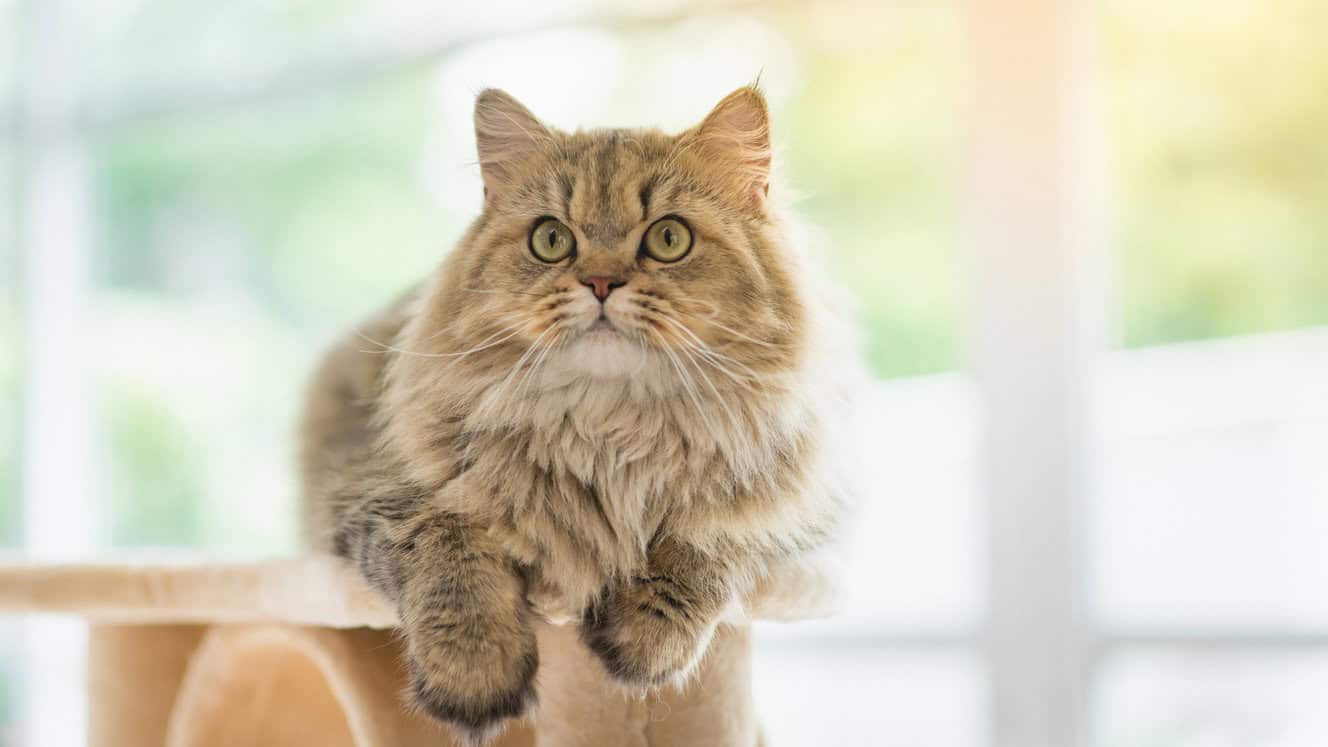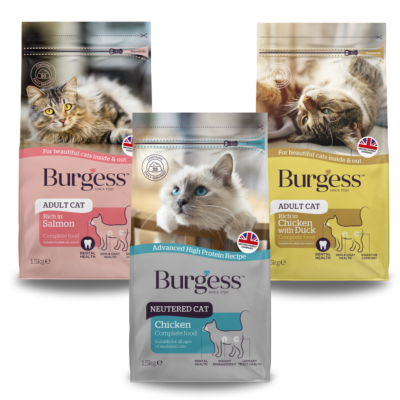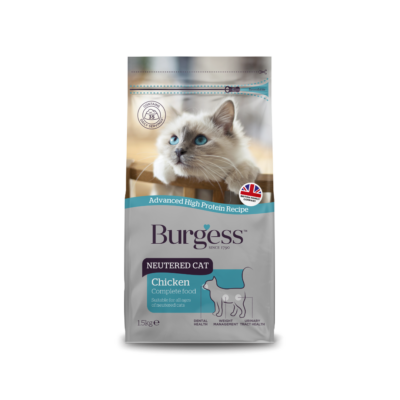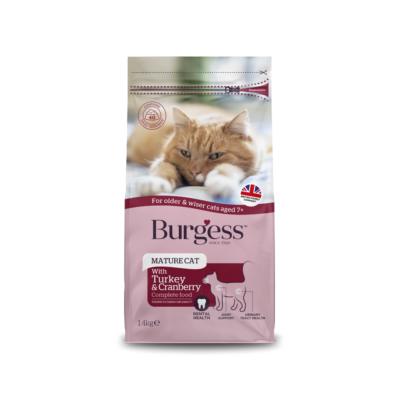

Expert approved
The ultimate glamour puss and placid creature of habit, the super-fluffy Persian, with its adorable round face and captivating large eyes, is one of the oldest and most recognisable cat breeds. Gentle, quiet, and easy-going, Persian cats will love lounging next to you and, when the mood takes them, will happily settle down in your lap.
“This particular breed is not often demanding,” says Petplan. “As long as they get some affection, and their food, litter and grooming needs are met, your Persian cat is likely to be a quiet companion.”
You may find, however, that it won’t be long before your Persian cat will have you wrapped around their little furry paws! “Don’t be fooled by their good looks! Persians are extremely intelligent,” notes the Governing Council of the Cat Fancy (GCCF). “They communicate with you with their expressive eyes and expect you to understand their wishes – they will also look at you incredulously when you misunderstand them, after all you are supposed to be intelligent!”
WHAT DO PERSIAN CATS LOOK LIKE?
“Persian cats are one of the oldest cat breeds in the world. Their snub noses and round faces mean they’re instantly recognisable as belonging to an established purebred cat breed,” says Petplan.
With small, round-tipped ears, large, wide-apart eyes and short, broad nose, Persians are renowned for their sweet, open expression. They have a short neck, broad chest and shoulders, thick legs and large, round paws.
“The long, luxuriant coat is the hallmark of the Persian,” enthuses The International Cat Association (TICA). “A heavy ruff surrounds the head, the coat flows over the body reaching to the floor in top examples of the breed and the tail is a thick flowing plume.” In fact, because of their long, thick fur, they often look bigger than their actual body size.
When it comes to colours, with Persians, you’re spoilt for choice, as this breed comes in many different coat colours and patterns. These include black, white, blue, red, cream, chocolate and lilac, silver, smoke, tabby, tortoiseshell, tortie and white, and colourpoint, where ears, face, paws, and tail are darker than the rest of the body.
WHERE DID PERSIAN CATS COME FROM?
With such exotic, glamorous looks, many romantic stories have evolved about the origins of Persian cats, yet, like many breeds, it remains a bit of a mystery. While some sources suggest that longhaired cats have existed in the Middle East for thousands of years, recent research has revealed that Persians actually have genetics in common with cats from Western Europe.
TICA says: “While the history of the Persian breed is mainly unrecorded, we do know it has been around for centuries. The Persian has been a popular pet since the dawn of the cat fancy (the various organisations worldwide that started to register pedigree cats and regulate breeding standards) in the late 1800s.”
Read on to find out more about Persian cats. Do they require a lot of care? Are they good with children and other pets? What do Persian cats like to do? From grooming and playtime to feeding, find out how to provide Persian cats with everything they need to live a fulfilling and happy life.
But first, check out these Persian cat facts!
8 FABULOUS PERSIAN CAT FACTS
- Persian cats are medium in size. Adult females weigh between 6 to 12 pounds (2.7 to 5.4kg) and adult males 9 to 13 pounds (4 to 5.8kg).
- Persian cats are the most popular pedigree cat breed in the USA, and the sixth most popular breed in the UK.
- Persian cats have incredibly soft, silky fur. While each individual hair is fine, the sheer amount of them is what gives Persians their signature dense coat.
- Persian cats may have a double or triple coat, depending on their genetics, meaning it’s smoother on the outer coat with frizzier hair underneath.
- Persian cats come in a pretty much unlimited number of coat colours and patterns.
- Persian cats first took London by storm when they were shown at the world’s first organised cat show in 1871 at the Crystal Palace, London.
- Persian cats have been unforgettable feline film stars – James Bond supervillain, Ernst Stavro Blofield, loved to stroke his snowy-furred Persian in several of the blockbuster movies. In the 2001 spy comedy, Cats & Dogs, Mr Tinkles, a white Persian cat, plans to exploit research into dog allergies to conquer the world!
- Persian cats feature prominently in the ‘world’s largest cat painting’, which sold at auction in Sotheby’s, California, for an astounding US$826,000.
PERSIAN CAT PERSONALITY PROFILE
If you’re looking for a chilled-out cat companion who loves plenty of lap time, then a Persian could be your ideal feline friend.
“Persian cats are typical lap cats when well socialised as young kittens,” says Petplan. “They like to be still, comfy and in peace and quiet. Once they are comfortable in their environment, they are affectionate, warm and calm.”
An ideal cat for chilled-out families
According to the GCCF, the Persian’s laid-back temperament makes them excellent family pets: “The Persian has a sweet, gentle nature and blends easily into most households as they become comfortable in their new home. They are creatures of habit and prefer a calm atmosphere and gentle handling. They have quiet, musical voices but communicate mainly with their large expressive eyes. The Persian cat will not demand your undivided attention, but it will relish your attention when are ready to lavish some time on it.”
“They are an adaptable breed and will enjoy living with any family as long as they are loved and treated gently,” adds TICA. “Persians will stretch out next to you, sleep in your bed, and sit on your lap when they are in the mood. They are generally friendly with everyone.”
This mellow feline is usually unbothered by most situations. Petplan notes: “Persian cats are usually docile and calm, rarely getting irritated, even in play. If they find themselves in a situation that they find unpleasant, they are more likely to leave a room than hiss or scratch.”
Detaching themselves from any circumstances that they’re not comfortable with means that Persians are sometimes perceived as being a bit distant and unapproachable, but Petplan argues that this is not a true depiction of their gentle, caring ways: “They’ve got a reputation for being a little aloof or reserved sometimes, simply because they aren’t quick to react, are not often vocal, and are very peaceful in nature. Persian cats can seem standoffish with strangers, but they’re loving, affectionate and loyal once they bond with one person, like their owner.”
Understand your cat better with our cat communication guide >>
IS MY HOME SUITABLE FOR A PERSIAN CAT?
If your homelife is mainly peaceful and calm, with plenty of cat-friendly features, a Persian cat will fit in very happily.
“Persian cats prefer quiet homes, which means they aren’t a fan of loud noises, unpredictable children or boisterous pets,” says Petplan. “Persians naturally bond with gentle people and could get along with other laid- back pets, as long as they are well socialised, introduced slowly and their needs are respected.”
“They are happy to be combed and petted by children but are unlikely to join in boisterous games with them,” adds the GCCF. “Persian cats can be perfect lap cats, but they might not be the breed for you if you have a young family or noisy pets. If you regularly have visitors ensure your Persian cat has a safe place they can escape to, like a spare bedroom,” advises Petplan.
Persians are also quite self-reliant and can handle being left on their own for short periods. “These are gentle cats that are comfortable in their own homes whether you are there or not – but will also be happy to see you when you return,” notes the GCCF.
A cat that needs a lot of care
While Persians have quite undemanding ways, caring from them requires a big commitment. “While Persian cats’ personality and temperament tends to be passive and relaxed, their grooming, diet, environment and health needs mean that from an early stage in their life, they’ll need a lot of care,” advises Petplan.
Keeping your Persian safe from harm is also an essential requirement for these peaceable pets.
“Not only are Persian cats usually a large financial investment, and at risk of being stolen, but they are naturally non-confrontational, meaning they’re at risk of being hurt by territorial neighbourhood cats,” adds Petplan. “For these reasons, many owners prefer to keep Persians as indoor cats, although it’s important that their welfare needs are met. Of course, cats benefit from the stimulation of an outdoor environment and if you can create a secure outside space, such as a ‘catio’ or enclosed garden, then a Persian cat will be happy in the fresh air.”
WHAT DO PERSIAN CATS LIKE TO DO?
While every cat is an individual with a unique set of likes and dislikes, there are certain things that are extremely important to Persian cats.
Top of the list is interaction with their human family, predictable everyday routines, and some gentle games.
“They like routine and a calm atmosphere, and won’t be found leaping on to high places, although they are playful and enjoy interaction with their human family,” says Your Cat. “Affectionate and tactile, they enjoy being gently handled and to sit on your lap or beside you. They have quiet voices, but know how to get your attention, usually by gazing at you with their large, lustrous eyes.”
“They like the security of the ground and are unlikely to be found leaping to the top of bookcases to explore the high ground,” says the GCCF. “They eagerly play with a toy or a teaser but are equally happy to drape themselves decoratively in a favourite spot!”
Persians, like all cats, do have their ‘mad’ moments! “Cats in the Persian Breed Group are placid and exhibit bursts of kitten-like activity. They can be sleeping in the sun one minute and suddenly explode into action, running through the room and rolling around the next,” notes TICA. “Persians like to play with interactive toys, chase balls, and catnip mice, but you might have to keep after them to exercise on a daily basis.”
“It’s important to have a few short sessions of play each day to keep your cat stimulated,” advises Petplan. “Ensure that you rotate the toys regularly so that your cat does not get bored. Play sessions will help them maintain a healthy weight.”
While most Persians aren’t a particularly trainable breed, their love of being fastidiously clean means that they’ll catch on to litter training quite easily. “All cats can benefit from training in order to provide mental enrichment,” adds Petplan. “Tips for training Persian cats include beginning the training while they are young and having lots of patience. They tend to quickly pick up litter tray training using positive reinforcement.”
GROOMING YOUR PERSIAN CAT
Due to their long, dense fur that’s prone to forming mats in tricky-to-get-at areas, Persians need daily grooming.
“One of the many reasons owners fall in love with the Persian breed is because of their characteristic long, fine coats. As a result, Persian cats shed a lot, and you’ll need to groom them every day – making sure kittens get used to grooming during the socialisation period,” advises Petplan. “This particular feline can be prone to hairballs, and they can’t keep their coat mat free by themselves due to jaw abnormalities.”
“As with all longhaired cats, the coat requires continuous care to ensure it is free from tangles and matting does not occur,” says the GCCF. “This need not be an onerous task; five- or 10-minutes careful combing each day will ensure your Persian looks good and feels comfortable.”
“The best tools for this are combs, rather than brushes, and a wide-toothed comb, plus a smaller comb for the face and legs are all that are required,” adds Your Cat. “Particular attention should be paid to the areas under the front legs, the trousers, and under the tail.”
Experts recommend buying specific Persian cat grooming tools, combs and brushes to help manage their long fur. Longer-toothed grooming combs help with their undercoat, and brushes smooth their outer coat. “Regular professional grooming sessions may need arranging, in addition to daily brushing,” says Petplan. “They may need the fur around their paws and bottom to be clipped to help them keep themselves spick and span.”
The insurer notes that Persians can be prone to dental problems. Using dental treats and brushing their teeth daily can be helpful. In addition, opting for high quality dry food has the added benefit of exercising your cat's chewing muscles and provides a mild cleaning effect on the teeth.
Persian cats can also suffer from excessive eye watering, known as ‘tearing’, due to the shape of their face affecting the tear ducts, so they can’t drain properly. This may cause the fur around the eye area to become darker and stained. “You’ll need to regularly wipe each eye with a different clean, fresh cloth to prevent infections and long-term staining,” recommends Petplan.
Regular grooming is not only great for bonding, but enables you to see any irregular lumps, bumps, bites and scratches.
FEEDING YOUR PERSIAN CAT
All cats – from tiger to domestic tabby – are obligate carnivores, which means they must eat meat to survive. Meat contains essential amino acids which they can’t make themselves. Cats also require high levels of protein and can benefit from food that’s appropriate for their life stage.
Industry body UK Pet Food states: “Cats vary from many species, requiring a significant amount of protein in their diet, plus certain nutrients, such as taurine, as part of a balanced diet with just the right amount of fats, carbohydrates and essential vitamins and minerals, to stay in peak condition. Nutrients must be present in the correct amounts for their stage in life and in the correct proportion to each other, in order to provide a nutritionally complete and balanced diet.”
Quality and quantity are the watchwords
“Similar to any cat, the Persians need proper protein and nutrients. A high-quality diet is recommended. After spaying/neutering, they have a greater tendency to become overweight, as with any cat. Owners should be aware of both the quality and quantity of foods being fed,” notes TICA.
“Persian cats can be a little messy when eating. Their flat faces and the structure of their noses and jaws mean that eating can sometimes be tricky. We recommend feeding cats in a shallow, wide dish,” adds Petplan.
Burgess in-house vet Dr Suzanne Moyes MVB, MRCVS advises: “Along with high protein levels, cats require a careful balance of vitamins, plus the essential amino acid taurine necessary to promote a healthy heart and eyes. A complete diet will have all the necessary vitamins, minerals, essential fatty acids and amino acids in the right ratio.”
How much and how often should you feed your cat?
Adult cats are generally fed twice a day. Alternatively, as cats in the wild naturally eat lots of small meals per day, you could try splitting their daily intake into several small meals (unless advised otherwise by your vet). Providing dry cat food in a variety of ways, such as in treat balls or cat puzzles, can deliver a much more exciting and rewarding experience for your cat.
Portion control is also important, so get into the habit of measuring out accurate amounts each day. Giving your cat a little more than they need means they could become overweight. Likewise, if you don’t feed enough, your cat will not get all the nutrients they need and will become underweight
Dr Moyes adds: “By following the on-pack instructions, it’s easy to measure out exactly the right-sized portion that’s suitable for your cat’s age and lifestyle to ensure they consume the correct amount of nutrients. For instance, house cats may need fewer calories than cats who spend much of their day roaming outdoors. Dry cat food is a good option as it’s easily portioned, may be better for dental health and encourages extra water consumption.”
Wet food v dry food
Unlike wet cat food, dry cat food stays fresh inside the pack until you’re ready to serve it to your cat – and your Persian won’t get messy eating it. And that’s not all! Other benefits include:
- Free feeding – As dry food can be left out because it won’t spoil, this suits those cats who prefer to graze their food over the day rather than at specific mealtimes.
- Helpful for healthy teeth – Munching on crunchy kibble encourages chewing and helps to keep teeth clean
- Makes feeding more fun – Dry food is easier to use with food dispensers and puzzle toys, providing environmental enrichment and mental stimulation.
- Portion control – By following the on-pack instructions, it’s easy to measure out exactly the right-sized portion to help your cat maintain a healthy weight.
Make sure to supply plenty of fresh water, too, in a separate place from their feeding area. Lots of cats aren’t keen on drinking water from a bowl, preferring moving water to still – so it may be worth investing in a cat fountain if you don’t want them drinking from a dripping tap!
“As with all cats, it is important to give your cat fresh, clean water daily, so they don’t hesitate to drink,” says TICA. “If you worry about your cat drinking enough water each day, here’s a tip from some cat behaviourists: place the water bowl at least three feet away from any food. Cats’ noses are sensitive, and an overwhelming smell of food may cause them to drink less. Many Persians do better with water fountains. It helps keep the hair on their chin and chest drier.”
GETTING A PERSIAN CAT
If you’re interested in adding one of these fabulous felines to your family, find out as much as you can first and decide if you’ll be able to provide them with everything they need to be a truly happy and contented cat.
“Before bringing a new cat home, it’s important to get expert advice. Speak to the cat’s breeder, experienced owners, and your vet in advance. This is even more important if you’ve never owned a cat before,” advises Petplan.
Be aware that Persians are a brachycephalic (flat-faced) breed and, due to their large, rounded skull and shortened face and nose, can be prone to certain health problems. “This facial conformation may make individuals prone to breathing difficulties, skin and eye problems,” says the GCCF. “Persians are prone to a disease called hypertrophic cardiomyopathy, which can lead to heart failure. Whilst this condition is not curable, it can be treated with lifelong medication,” adds Petplan.
If you’re looking for a kitten, only ever buy from a reputable, registered breeder.
Alternatively, visit the Strawberry Persian & Pedigree Cat Rescue and the St Francis Persian Cat Rescue Facebook page to find beautiful cats looking for happy new homes. Also check out other rescue charities such as Cats Protection, Battersea, Blue Cross, RSPCA and Woodgreen, who’ll be delighted to hear from you, and can provide you with lots of helpful advice on adopting a rescued cat.
EVERY CAT DESERVES A DELICIOUS, NUTRITIOUS DINNER!
At Burgess Pet Care, all our cat food is made using premium ingredients to ensure excellent quality and superior taste to help keep your cat happy and healthy – from kitten, to adult and mature and Burgess Neutered Cat with Chicken – an advanced, high protein, complete food with added L-Carnitine to help maintain a healthy weight.
- Salmon? Duck? Chicken? Let your adult cat pick their favourite flavour with our fussy cat bundle >>
- Our cat diet and nutrition guide is here to help you create a meal plan that's tailored especially for your feline friend.
- How often should you feed your cat? Find out why little and often suits most cats – and the reason why play should be part of your feeding routine.
- Adapting your cat’s diet throughout their life What you choose to feed your cat can make all the difference.
CARE MORE Find out more about caring for your cat from Burgess, the Pet Care Experts.
Is your cat a Burgess cat? Join our Pet Club for exclusive offers and competitions – and expert advice from our in-house vet, Dr Suzanne Moyes.
If you found this interesting, you may also like:
CARING FOR KITTENS Discover how you can help your kitten get the very best start in life.
KITTEN TIMELINE – WHAT ARE YOUR KITTEN’S MILESTONES? When will my kitten eat solid food? When will my kitten start to purr? When will my kitten be able to go outside? Mark your meowing munchkin’s milestone moments with our comprehensive kitten timeline.
THE NEXT BIG STEP FOR YOUR LITTLE CAT When does your kitten become a cat? What changes will you see in their behaviour? When do you need to switch them over from kitten to adult cat food – and what are the nutrition differences that benefit them as they grow?
CATS – WHAT’S GOING ON DURING THE ‘TEENAGE’ PHASE? Is your young cat suddenly bursting with energy, wanting to play at weird times, and fiercely guarding their favourite hang-out spots before going off in a huff? It’s likely you have a ‘teenage kit’ on your hands.
A LITTLE EXTRA HELP FOR OLDER CATS When our beloved cats get older, it’s our job to make their life as comfortable as possible. Their fast-paced days of crazy kitten antics may be a distant memory, but they still possess the desire to exhibit their natural feline behaviours – they just need a little help from us.
CAN YOU TRAIN A CAT? Felines excel at training their human guardians to give them food, attention and a cosy lap to curl up on. But is it possible for us to train them?
ALL ABOUT RAGDOLL CATS Gentle, genial and generally laid-back about life, Ragdolls are the perfect choice if you long for a large, fluffy cat who will follow your every move and may even hide ‘finds’ in your shoes...
ALL ABOUT MAINE COON CATS Playful, loyal and surprisingly placid, Maine Coons make excellent companions for people who want to share their days with a big, furry cat with a gentle, affectionate nature.
ALL ABOUT BENGAL CATS Are Bengals friendly and affectionate? Are they active and playful? Do they really have glittery fur? Get all the answers in our guide to beautiful Bengal cats.
ALL ABOUT NORWEGIAN FOREST CATS Do Norwegian Forest cats need lots of space to play and explore? Are they affectionate lap cats or do they have a more independent nature? Find out in our guide to these fabulously fluffy felines.
ALL ABOUT BRITISH SHORTHAIR CATS Gentle, affectionate and independent, discover why super popular British Shorthairs have just what it takes to be the ideal family cat.
CAT BREEDS – TAKE A CLOSER LOOK AT SOME OF THE UK’S MOST POPULAR TYPES OF CAT Siamese or Bengal? Norwegian Forest or Maine Coon? Ragdoll or Russian Blue? Which breed of cat do you find most captivating? We count down 10 cat breeds that are riding high in the popularity charts, plus one favourite feline that’s not actually a breed at all…
PLAY WITH THIS – NOT THAT! HOW TO CHOOSE THE BEST CAT TOYS Cats love stalking things, chasing things, and exploring things with their paws and teeth, which can sometimes lead to a whole mess of trouble. Introducing a selection of feline-friendly toys will keep your pet entertained while ensuring they won’t come to any harm.
HOW TO HANDLE YOUR CAT Cats like to feel in control of whatever situation they’re in and are quick to show when they’re not happy. Never is this more evident when it comes to being handled when they don’t want to be.
DOES YOUR CAT KNOW THEIR NAME? Whatever name we choose to bestow upon our beloved pet cats, does it make any difference to them? Do they actually understand that they’re called Alfie or Bella or even Archibald von Snugglemuffin?
ARE YOU AND YOUR CAT MORE ALIKE THAN YOU THINK? If you have a grumpy Tabby cat, a super friendly Ragdoll cat, or fiendishly feisty Bengal cat, could this actually say more about you than your pet?
10 THINGS I HATE ABOUT YOU Super tidy house? Cleaning blitzes? Cuddle overload? If our feline friends could tell us what they really think, here’s what they’d probably say about some of the things we do that they’re none too happy about…
WHEN SHOULD YOU NEUTER YOUR CAT? As well as preventing unwanted pregnancies, neutering benefits your favourite feline’s health and wellbeing in all sorts of ways. In fact, feline experts believe it’s the kindest thing you could do for your cat.
HOW TO TELL IF YOUR CAT REALLY LOVES YOU While you may adore your captivating cat, how does your enigmatic feline companion feel about you?
MUSIC TO THEIR FURRY LITTLE EARS? What’s on your playlist? Cat Stevens? The Stray Cats? The Pussycat Dolls? And have you ever wondered if your cat appreciates your taste in music, or would they prefer music created especially for them? Yes, it’s a thing!
PLAY BEHAVIOUR OF CATS SURPRISES SCIENTISTS While there are lots of things that cats do which cause scientists plenty of head-scratching moments, new research into the way that cats play has resulted in some rather baffled boffins...
THE EYES HAVE IT When it comes to the mysterious task of understanding cat language, focusing on one of a feline’s most appealing features – their captivatingly beautiful eyes – could be the key.
SHOULD LILIES CARRY A HEALTH WARNING? Did you know that lilies are so poisonous that a cat can suffer fatal kidney failure just from nibbling a leaf, licking pollen off their coat or even from drinking water from a vase with cut lilies in it?
DOES YOUR CAT RECOGNISE YOUR HAPPY FACE? How do cats see humans? Do cats recognise faces? Do cats remember people? Do cats miss their owners? Do we own cats or do cats own us?
IS YOUR CAT REALLY MAD AT YOU? Whether it’s because you’ve had to take them to the vet, or you accidentally stepped on their tail, your cat may give you the impression that they’re really cross with you. But can cats really hold grudges?
MY CAT IGNORES ME – WHY? Unlike dogs, who generally want to be involved in every situation, cats are known for being independent. While some cats can be quite social, it can be hard to take when your favourite feline seems to take absolutely no notice of you. So why is this the case?
GIRLS V BOYS – FELINE MYTHS AND MISCONCEPTIONS Do male and female cats act differently because of their gender? Are generalisations about laid back, lap-loving boys and aloof, independent girls simply myths – or is there any truth to them?
THE HOMING INSTINCT – CAN CATS REALLY FIND THEIR WAY HOME? Top tip – it’s much easier if they’re microchipped! Plus, what a change in the law means for every cat owner…

















